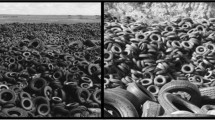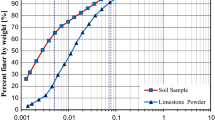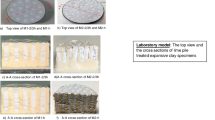Abstract
In areas where heavy clays predominate (clays with plasticity index of more than 27), engineers always face the problem of replacing soils when constructing a roadbed for railroads and highways. Transportation of suitable construction material, as a rule, is very expensive. Construction of the roadbed of railroads and highways, especially in the cold regions of the Russian Federation, is almost always accompanied by a shortage of soils with good physical and mechanical properties. As a rule, these areas are characterized by clay deposits with unfavorable properties: high degree of swelling, low hydration strength, poor compaction, etc. Such properties are also characteristic of heavy clays which are widespread not only in Russia but also abroad. These features of heavy clays do not allow them to be used in the construction of the roadbed of railroads and highways without taking measures to improve their properties. The same problem has been faced by the engineers involved in the construction of the railroad track on the Taman Peninsula. Heavy swelling clays are common for this area. In the summer of 2017, soil samples were taken from the Taman Peninsula and tested in the laboratories of St. Petersburg State Transport University (PGUPS). Physical and mechanical properties of heavy clays were studied as well as properties of reinforced clays. The research shows that the optimal method for improving physical and mechanical properties of heavy clays (swelling, deformability) is the creation of a composite material consisting of heavy clay with the addition of dust filled sand (10% of the mass) and grade M400 cement (3% of the weight). This technique is applicable to all areas where heavy clays are common.
Access this chapter
Tax calculation will be finalised at checkout
Purchases are for personal use only
Similar content being viewed by others
References
Set of rules (2015) SP 238.1326000.2015 Railway Track. Ministry of Transport of the Russian Federation. Moscow. p 71
Directive Deutsche Bahn Gruppe Ril 836.0501 Earthworks. Mound Principles
Standards of the International Union of Railways (UIC) UIC 719R (2008) Earthworks and ballast section for railway tracks
Prokudin IV, Spiridonov ES, Grachev IA, Kolos AF (2008) Organization of the construction and reconstruction of railways. Under the editorship of Prokudin IV, Educational and methodological center for education on the railway transport, p 736
Dashko RE, Shidlovskaya AV Physico-chemical nature of swelling and osmotic shrinkage of clay rocks at the base of structures based on the results of experimental studies. Zapiski Mining Institute, vol 200. pp 193–200
Osipov VI (1979) The nature of the strength and deformation properties of clay rocks. Publishing House of Moscow State University, Moscow, p 235
Zvereva IA, Lbova DS, Kachenov VI (2016) Study of the swelling of clay soils as the foundations of structures. Modern technologies in construction. Theory and practice pp 420–423
Danilov VI et al. (1988) On soil softening under the influence of the processes of swelling—shrinkage. Soil Sci J 6:59–70
Egorov YK, Pakhomov SI, Kail EV (1988) Investigation of the properties of swelling soils, No. 88–5. TSNTI, Stavropol, p 3
Christodoulias J (2015) Engineering properties and shrinkage limit of swelling soils in Greece. J Earth Sci Climatic Chang 6(5):1–6
Osipov VI, Nguen NB, Rumjantseva NA (1987) Cyclic swelling of clays. Appl Clay Sci, Amsterdam pp 363–374 Elsevier Science Publishers B. V.
Hashim R, Muntohar A, Al-Rawas AA, Goosen MFA (2006) Swelling rate of expansive clay soils. Expansive soils: recent advances in characterization and treatment, pp. 139–148
GOST 25100-2011 (2018) Soils Classification. Standardinform, Moscow p 38
Lazorenko GI (2011) Theoretical study of the effect of nano-additives on the physical properties of montmorillonite clays, Don. Eng J, Rostov-on-Don pp 100–103
Omar M, Shanableh A, Al Zaylaie M (2016) Modification of the swelling characteristics and phosphorus retention of bentonite clay using alum. Soils Found 56(5):861–868
Mirzababaeia M, Arulrajahb A, Oustonc M (2017) Polymers for stabilization of soft clay soils. Procedia Eng 189:25–32
Estabragh AR, Moghadas M, Javadi AA (2013) Effect of different types of wetting fluids on the behaviour of expansive soil during wetting and drying. Soils Found 53(5):617–627
Phanikumara BR, Singlab R (2016) Swell-consolidation characteristics of fibre-reinforced expansive soils. Soils Found 56(1):138–143
Sasaniana S, Newsonb TA (2014) Basic parameters governing the behaviour of cement-treated clays. Soils Found 54(2):209–224
Kamei T, Ahmedb A, Ugai K (2013) Durability of soft clay soil stabilized with recycled Bassanite and furnace cement mixtures. Soils Found 53(1):155–165
Ma C, Qin Z, Zhuang Y, Chen L, Chen B (2015) Influence of sodium silicate and promoters on unconfined compressive strength of Portland cement-stabilized clay. Soils Found 55(5):1222–1232
Kotelnikov DD, Konyukhov AI (1986) Clay minerals of sedimentary rocks. Nedra, Moscow, p 247
Ladinsky AS (1932) Standard case/Ing. A. Ladinsky. East Inst. – Sverdlovsk Uralogiz, Moscow
Author information
Authors and Affiliations
Corresponding author
Editor information
Editors and Affiliations
Rights and permissions
Copyright information
© 2020 Springer Nature Singapore Pte Ltd.
About this paper
Cite this paper
Kolos, A., Alpysova, V., Osipov, G., Levit, I. (2020). The Effect of Different Additives on the Swelling Process of Heavy Clays. In: Petriaev, A., Konon, A. (eds) Transportation Soil Engineering in Cold Regions, Volume 2. Lecture Notes in Civil Engineering, vol 50. Springer, Singapore. https://doi.org/10.1007/978-981-15-0454-9_31
Download citation
DOI: https://doi.org/10.1007/978-981-15-0454-9_31
Published:
Publisher Name: Springer, Singapore
Print ISBN: 978-981-15-0453-2
Online ISBN: 978-981-15-0454-9
eBook Packages: EngineeringEngineering (R0)




